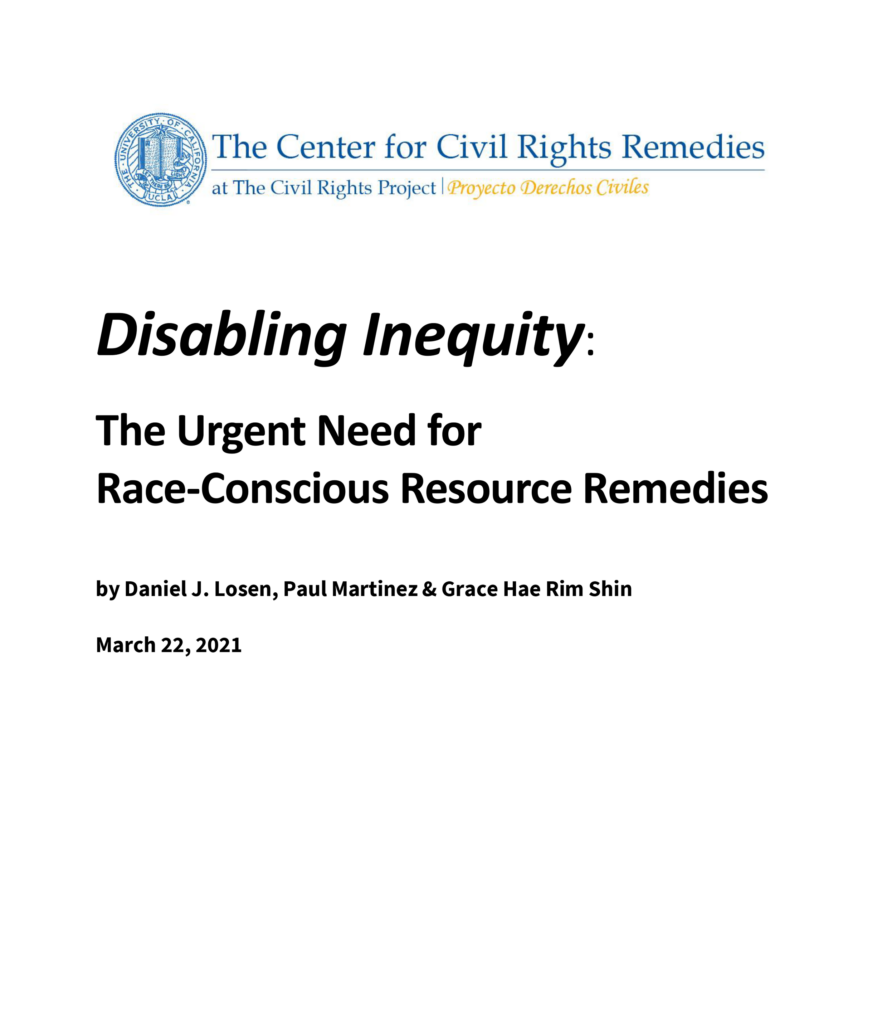EXECUTIVE SUMMARY (excerpts)
This report has three parts.
Part I demonstrates that there is a large subgroup of students with disabilities who have a right to receive supports and services but whose needs appear to be ignored in many large districts all across the nation. When most people think about students with disabilities they think of the roughly 7 million students that are deemed eligible for special education, as required by the Individuals with Disabilities Education Act (IDEA). But there is another large and growing group of nearly 1.4 million students with disabilities that districts are supposed to identify and support, even though they do not necessarily require specialized instruction. Another federal anti-discrimination law, Section 504 of the Rehabilitation Act of 1973, protects both types of students from disability discrimination: those who need special education and those who do not. Section 504 requires all public schools that receive federal funds to identify those that do not require specially designed instruction, but do have a disability that substantially limits one or more major life activities. Districts must provide a wide range of supports and services to these students known as “504-only” students, to ensure that they, too, receive a FAPE.
The 504-only students often include those with ADHD, depression, anxiety disorders, students who have experienced trauma, and many others who may need mental/behavioral health services on a regular basis. Some 504-only students may need a wide range of supports and services, in and out of the classroom including modifications in their classroom from their teacher to help them with attention, organization, processing or behavioral challenges. Others may only need regular assistance from a school nurse for conditions like diabetes, asthma or food allergies. Although 504-only students typically do not include students with the most severe needs, the range of disability types and extent of needed supports and services is quite broad.
Part II of this report focuses on the school experiences of students with disabilities who are eligible for special education and related supports and services under the IDEA and who constitute close to 14% of all public-school students in grades K-12. We examine three outcome areas: disciplinary exclusion, referral to law enforcement, and chronic absenteeism. In each area we find glaring disparities, which are far worse for non-White students receiving special education.
Part III reviews the evidence that the pandemic is exacerbating the pre-existing inequitable conditions and concludes with recommendations for federal policymakers. It begins by examining the rising incidence of childhood trauma and mental health problems, which have likely created additional racially disparate burdens during the pandemic. These include greater exposure to violence or abuse in the home, loss of family members to COVID-19, parents losing jobs, and evictions. According to the Centers for Disease Control and Prevention (CDC), there has been a steep increase in depression and anxiety disorders, and these adverse experiences can contribute to the development of a disability. Part III also summarizes findings from studies demonstrating that, mid-pandemic, students with disabilities are losing much more instructional time than their non-disabled peers.
Part III concludes with specific federal policy recommendations based on this report’s research findings including the following:
1) Bolster civil rights enforcement and the capacity to bring about substantive change when responding to systemic discrimination: Reinstate the federal DOJ/OCR school discipline guidance issued in 2014, and add explanations and examples of how disparate impact also applies to the discipline of students with disabilities and the disparate impact that burdens students of color with disabilities from unsound discipline policies and from the failure to provide required behavioral supports; create a system to flag for possible investigation those large districts that report enrolling no 504-only students; collect, publicly report and review civil rights education data annually, starting with 2019-20; boost civil rights investigations into systemic discrimination; provide additional incentives and technical support to ensure that accurate data are reported to the public, especially the data on school policing, and used to investigate high rates and large disparities in referrals to police by race, disability and the confluence of the two.
2) Expand federal funding to eliminate the shortages of counselors, social workers, nurses, school psychologists and well trained fully certified special education teachers: Provide incentives for state funding to cover students experiencing trauma and for 504-only students; include accountability for states like Ohio that have not provided adequate or equitably distributed resources and have been found in violation of their own state constitutional mandates.
These are just some of the important steps that the federal government will need to take so that the pandemic recovery does not simply return students with disabilities to the gross inadequacies and racial inequities of the pre-pandemic status quo.
In compliance with the UC Open Access Policy, this report has been made available on eScholarship: escholarship.org/uc/item/2pw440h5
